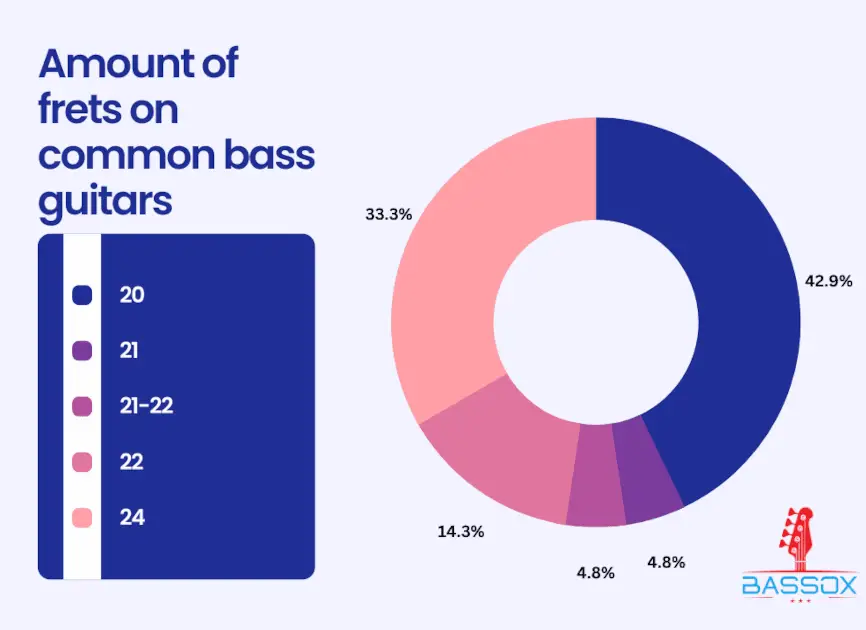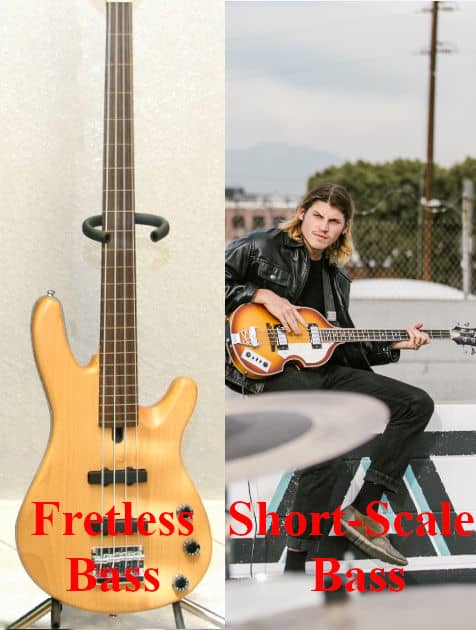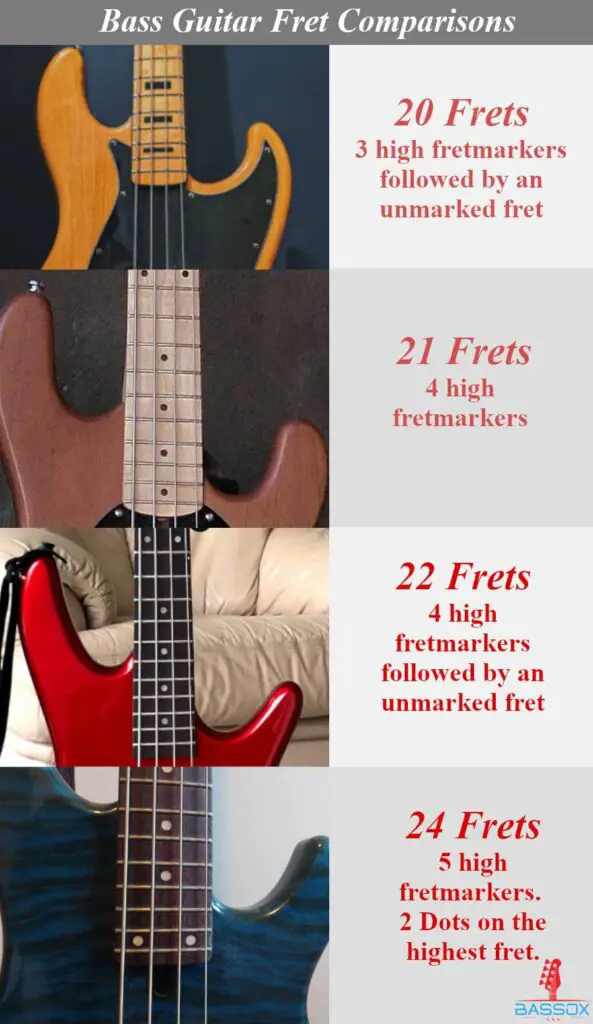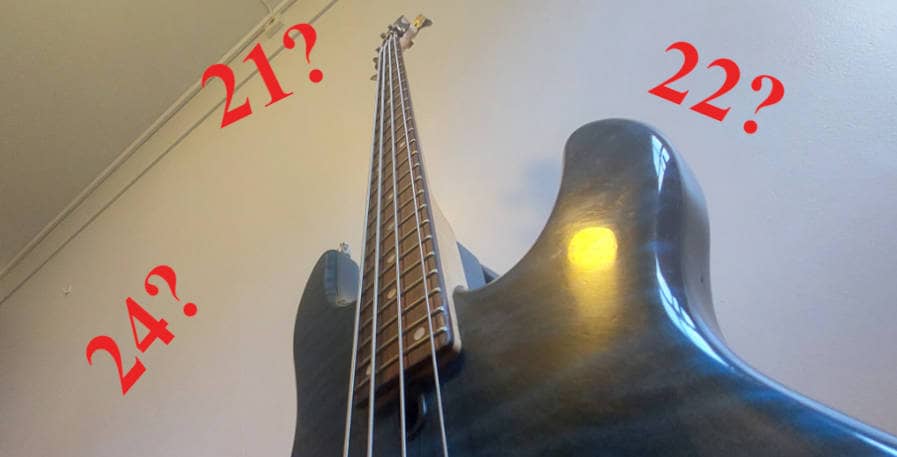Whether you are looking to pick up your first bass or are in the early stages of learning it, there is one question you will run into sooner rather than later. Namely, how many frets does a bass have?
Most bass guitars have either 20 or 24 frets. Many common bass guitars have 21 or 22 frets, though these are slightly less common. There also exist 19 and 26-fret basses, as well as fretless bass guitars. However, these are rarer than 20-24 fret basses.
So while basses differ in how many frets they have, the vast majority of them have 20-24.
For a more in-depth answer to this question, read on to find how many frets there are on the most popular types of bass guitars. I`ll also showcase what 26 and 19 frets look like, and how you can learn to easily tell how many frets a bass guitar has.
Amount of frets on common bass guitars
The best way to get an idea of how many frets bass guitars tend to have is to compare some common bass models. This is also helpful for anyone wondering how many frets a Fender Jazz, or any particular type of bass guitar, has.
Thus, here is a table with some of the most common bass guitars, and how many frets they have.
| Bass Guitar: | Number of Frets: |
| Fender Precision | 20 |
| Fender Jazz | 20 |
| Squier Precision | 20 |
| Squier Jazz | 20 |
| Musicman Stingray | 21-22 |
| Höfner 500/1 | 22 |
| Rickenbacker 4001 | 20 |
| Yamaha TRBX174 | 24 |
| Yamaha TRBX304 | 24 |
| Epiphone Thunderbird | 20 |
| Epiphone EB-3 SG | 22 |
| Gibson Thunderbird | 20 |
| Gibson SG | 20 |
| Schecter Omen Extreme | 24 |
| Steinberger Spirit XT-2 | 24 |
| Peavy Milestone | 20 |
| Ibanez GSR200 | 22 |
| Ibanez SR300EB | 24 |
| Ibanez SR | 24 |
| Sadowsky Standard JJ | 21 |
| Warwick Corvette | 24 |
As we can see, among these popular basses 20 and 24 frets are the most common amounts of frets.
For a different perspective on how many frets there are on most bass guitars, here is the above data compiled into a pie chart:

While this data is not representative of all types of bass guitars, it does tell us how many frets bassists typically need.
In other words, having 20 frets on a bass is enough for a whole lot of bass players, or else these basses would not be as popular as they are.
We can also deduce that there is no ideal answer to what amount of frets is the best. Bassists play a range of basses that have varying amounts of frets. Also, more often than not the amount of frets is a negligible part of why people choose to play a particular bass.
With that said, having fewer frets means that the range of the bass is reduced.
A 4-string bass with 21 frets will have exactly 3 octaves of range. I personally prefer having at least 21 frets for this reason, but it is by no means a dealbreaker, and I`ve rarely felt limited when playing a bass with 20 frets.
Thus, you don`t need 24 frets on a bass, though some bassists prefer the additional high range the extra frets provide.
Less common amounts of frets on bass guitars
While most basses have 20-24 frets, there are some exceptions. The most notable of these are basses with 19 or 26 frets.
Bass guitars with 19 frets are fairly similar to those with 20 or 21. You can play the vast majority of bass lines on them, though it remains uncommon for basses to have as few frets as this.
25 and 26 frets are more commonly found on high-end 5 and 6-string basses. There also exists 4-strings with 26 strings such as the Carlo Robelli SSB.
In general, higher-end expensive basses with 5 and 6-strings tend to have more frets than 4-strings. While this usually means that they have 24 frets, some push this to 25, or 26.

There are also fretless bass guitars.
While fretless basses don`t have physical frets, they do have a limited range similar to that of fretted basses. In general, this comes out to them having the same amount of range as 20-24 fret basses.
The fretless bass in the image below has fret lines. These serve a similar function to the dots on a fretted bass. Many fretless basses do not have these, making it more ambiguous how many frets of range they have.

Lastly, many beginners elect to start on a short-scale bass.
These are basses that are smaller in overall size. Thus, they are a great option for young musicians or bassists with small hands.
However, short-scale basses don`t have fewer frets than the common 34″ long-scale bass does. Due to its name, short-scale basses are commonly mistaken to have fewer frets, but they do in fact usually have 20-24.
How to tell how many frets a bass guitar has
When evaluating bass guitars, it`s helpful to be able to quickly tell how many frets it has.
The way I always do this is by looking at what type of pattern the fret markers make at the highest frets. These patterns are streamlined across practically all basses and are the same whether the frets are marked with lines or dots.
Thus, this infographic can be used to tell how many frets there are on any bass guitar instantly.

If you are new to string instruments, this might require a bit of memorization.
It will however not take long before it becomes second nature and you will be able to tell how many frets a bass has by quickly glancing at it. This will save a lot of time down the road, as you won`t have to look up or count how many frets the bass has ever again.
Conclusion
Some bassists don`t mind how many frets they have and largely stick to playing below the 12th fret anyway. I prefer having at least 21, but don`t mind having less. My latest basses have all had 24, and while I rarely use all 24 of them I prefer having more range if I ever should need it.
With that said, how many frets there are on a bass guitar is rarely a deal-breaker. The only downside to having fewer frets is that you will have slightly less high range. This can in rare cases limit you from covering songs without transposing certain notes down an octave.
Thus, 20, 21, 22, and 24 frets are all common on basses for a good reason. They all have more than enough range to not hinder your creativity and allow you to play the vast majority of songs out there.
For this reason, you can`t go wrong by picking up a bass with any amount of frets. If you prefer having the most amount of options possible, pick a bass with 24. I do however recommend focusing more on playability and tone when choosing a bass, rather than the number of frets.

